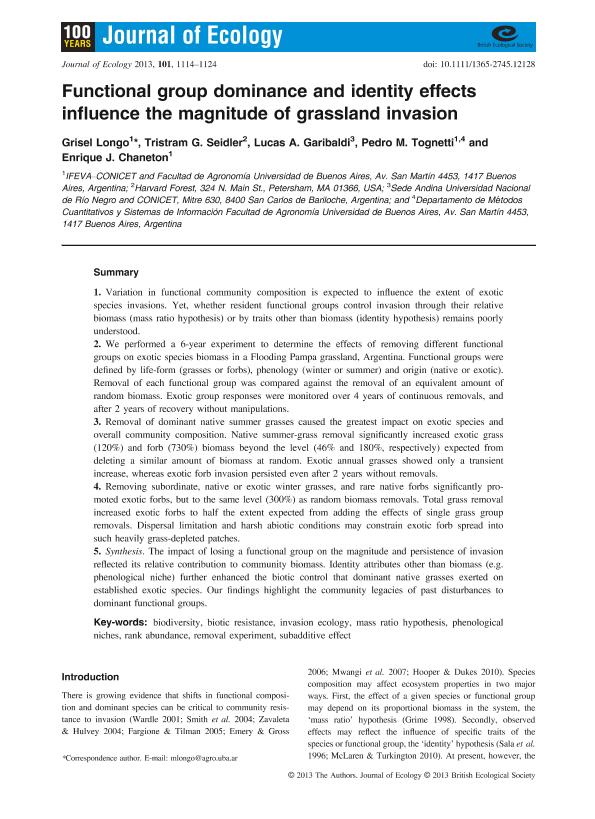Artículo
Functional group dominance and identity effects influence the magnitude of grassland invasion
Longo, Maria Grisel ; Seidler, Tristram G.; Garibaldi, Lucas Alejandro
; Seidler, Tristram G.; Garibaldi, Lucas Alejandro ; Tognetti, Pedro Maximiliano
; Tognetti, Pedro Maximiliano ; Chaneton, Enrique Jose
; Chaneton, Enrique Jose
 ; Seidler, Tristram G.; Garibaldi, Lucas Alejandro
; Seidler, Tristram G.; Garibaldi, Lucas Alejandro ; Tognetti, Pedro Maximiliano
; Tognetti, Pedro Maximiliano ; Chaneton, Enrique Jose
; Chaneton, Enrique Jose
Fecha de publicación:
09/2013
Editorial:
Wiley
Revista:
Journal of Ecology
ISSN:
0022-0477
Idioma:
Inglés
Tipo de recurso:
Artículo publicado
Clasificación temática:
Resumen
Variation in functional community composition is expected to influence the extent of exotic species invasions. Yet, whether resident functional groups control invasion through their relative biomass (mass ratio hypothesis) or by traits other than biomass (identity hypothesis) remains poorly understood.
We performed a 6-year experiment to determine the effects of removing different functional groups on exotic species biomass in a Flooding Pampa grassland, Argentina. Functional groups were defined by life-form (grasses or forbs), phenology (winter or summer) and origin (native or exotic). Removal of each functional group was compared against the removal of an equivalent amount of random biomass. Exotic group responses were monitored over 4 years of continuous removals, and after 2 years of recovery without manipulations.
Removal of dominant native summer grasses caused the greatest impact on exotic species and overall community composition. Native summer-grass removal significantly increased exotic grass (120%) and forb (730%) biomass beyond the level (46% and 180%, respectively) expected from deleting a similar amount of biomass at random. Exotic annual grasses showed only a transient increase, whereas exotic forb invasion persisted even after 2 years without removals.
Removing subordinate, native or exotic winter grasses, and rare native forbs significantly promoted exotic forbs, but to the same level (300%) as random biomass removals. Total grass removal increased exotic forbs to half the extent expected from adding the effects of single grass group removals. Dispersal limitation and harsh abiotic conditions may constrain exotic forb spread into such heavily grass-depleted patches.
Synthesis. The impact of losing a functional group on the magnitude and persistence of invasion reflected its relative contribution to community biomass. Identity attributes other than biomass (e.g. phenological niche) further enhanced the biotic control that dominant native grasses exerted on established exotic species. Our findings highlight the community legacies of past disturbances to dominant functional groups.
Archivos asociados
Licencia
Identificadores
Colecciones
Articulos(CCT - PATAGONIA NORTE)
Articulos de CTRO.CIENTIFICO TECNOL.CONICET - PATAGONIA NORTE
Articulos de CTRO.CIENTIFICO TECNOL.CONICET - PATAGONIA NORTE
Articulos(IFEVA)
Articulos de INST.D/INV.FISIOLOGICAS Y ECO.VINCULADAS A L/AGRIC
Articulos de INST.D/INV.FISIOLOGICAS Y ECO.VINCULADAS A L/AGRIC
Articulos(OCA PQUE. CENTENARIO)
Articulos de OFICINA DE COORDINACION ADMINISTRATIVA PQUE. CENTENARIO
Articulos de OFICINA DE COORDINACION ADMINISTRATIVA PQUE. CENTENARIO
Articulos(SEDE CENTRAL)
Articulos de SEDE CENTRAL
Articulos de SEDE CENTRAL
Citación
Longo, Maria Grisel; Seidler, Tristram G.; Garibaldi, Lucas Alejandro; Tognetti, Pedro Maximiliano; Chaneton, Enrique Jose; Functional group dominance and identity effects influence the magnitude of grassland invasion; Wiley; Journal of Ecology; 101; 5; 9-2013; 1114-1124
Compartir
Altmétricas



